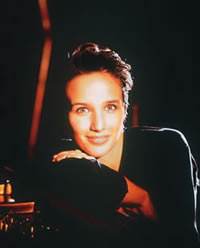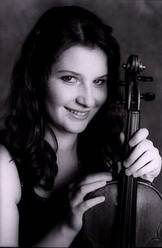S & H Concert Review
Czech Philharmonic, Vladimir Ashkenazy, Barbican, 12th –13th November, 2002 (AR)
Helene Grimaud, piano
Elisabeth Batiashvili, violin
Janacek Suite from The Cunning Little Vixen
Ravel Piano Concerto in G
Dvorak Slavonic Rhapsody Op 45 No 3
Dvorak Hussite Overture
Martinu Frescos of Piero della Francesca
Dvorak Violin Concerto
Debussy Jeux
Ravel Rhapsodie espagnole
Hearing the Czech Philharmonic Orchestra live, the first thing that strikes one is the depth of sound of the 'cellos and double basses so frequently lacking in our London orchestras. Equally striking is this orchestra’s deep toned brass, with its penetrating bite, whilst the strings have a sharp, angular, jagged quality; the very antithesis of those sweet and homogenised strings we associate with the Vienna Philharmonic. Many listeners accustomed to the smooth style of playing of classical symphony orchestras in the UK may find the Czech sound seems rather sour, even acidic in tone. However, far from being a defect, this is the appropriate sound to play the Czech music which featured heavily in the two concerts given by this great orchestra. Like the St. Petersburg (formerly Leningrad) Philharmonic, the Czechs have a distinctive grainy sound. However, what went against the orchestra was the Russian-born conductor, who blurred the orchestral textures and balance between players with his incoherent and, on occasion, inept conducting.
In the Janacek's Suite from The Cunning Little Vixen, Vladimir Ashkenazy did not seem to be really conducting or leading the orchestra; he had no sense of the dramatic contour of the work, sounding as it did so totally disjointed and uncoordinated. A disappointing start to the evening.
Things improved somewhat with Ravel’s Piano Concerto in G, played with great passion and precision by Helene Grimaud; this wonderful pianist combines great intelligence with a dazzling technique, her incredibly nimble fingers making short work of even the most difficult arpeggios. Unlike her conductor, she had total control, flare and rhythmic vitality. Unfortunately, sometimes her playing was engulfed by the hall's notoriously dry acoustic, and on occasion even drowned out by the orchestra’s excessively loud playing, due entirely to Ashkenazy's bombastic conducting. Being a renowned pianist himself, fellow feeling at least should have produced a far more sympathetic and sensitive accompaniment.In the Adagio assai the strings were far too full-toned, almost eliminating the impact of the cor anglais; this was solely due to the conductor's failure to grade the dynamics properly: the strings ideally need to sound more muted here. Again, the Presto lacked rhythmic bite and the essential jazzy inflection, so perfectly realised by Abbado (with Martha Argerich) at the Proms in 2002. Ashkenazy’s conducting was heavy handed with important dialogue between woodwinds and pianist smudged; the conductor totally misconceived this concerto, making it sound like a lush, full-blown 19th century romantic work rather than the chamber-like, witty 20th century work it is.
Part two of this concert consisted of just two short works by Dvorak: the Slavonic Rhapsody No.3 and the Hussite Overture. This must go down as one of the shortest second halves of a concert on record. The Slavonic Rhapsody was conducted in a rather foursquare manner, largely missing the essential lilt and rhythmic vivacity this music calls for. While the orchestra played with polish there seemed to be something almost routine and disinterested about their performance, and hardly any of the players were paying attention to the conductor.
The Hussite Overture was played with more flare, even if Ashkenazy's rhythms were rather pedestrian. Again, the conductor missed the drama and tragedy embedded in this music, conducting it more like a mere flashy show piece for orchestra, when it should be so much more than this. For instance, important dissonant brass passages were toned down, completely negating their dramatic emphasis. Throughout the concert there was no real rapport between conductor and orchestra. This was a concert producing an uncomfortable tension between some beautiful playing and bad conducting.
Surprisingly, after such as absurdly short second half, there was no encore and conductor and orchestra fled the stage only minutes after the applause begun. Some of the players clearly looked bored, with both the harpist and side drummer yawning. The audience seemed to evacuate their seats as fast as the players left the stage. It looked like a very efficient fire drill. The desultory applause was the shortest I have ever experienced at a classical concert.
Ashkenazy's second concert with the Czech Philharmonic Orchestra was badly attended and even more disastrously conducted than the first.
Martinu's The Frescos of Piero della Francesca is one of the most sublime and etherial pieces of music written in the 20th century. Karel Ancerl (1908-1973), who was Principal Conductor of the Czech Philharmonic between 1950 and 1968, recorded a paradigm performance of the The Frescos revealing the shifting textures and an acute sense of rhythm in this vibrant score. Under Ashkenazy's baton the music sounded bland and rhythmically flat, the entire work conducted all on one level, with no variation in dynamics or tension. He failed to register the translucent nature of this music making the string textures sound far to full-blown and heavy. The second movement, Adagio, lacked any sense of revelation and wonder, sounding merely opaque and formless. The last movement Poco allegro - was slack and too static: the rhythms should have been much more taut and angular and the brass interjections were not sharply etched. Important woodwind passages were blurred where they should have been pointed.
The Dvorak Violin Concerto was a disaster for both soloist and conductor. Elisabeth Batiashvili, a Georgian-born violinist in her early 20s, produced an ugly, shrill and scrawny tone, playing in a crude and disjointed manner, and largely devoid of legato. She scraped her way through the concerto with startling ineptitude. In the first movement she had absolutely no sense of phrasing at all: it was all on one screeching level. One was not aware that there even was an Adagio as she played it in exactly the same manner as both outer movements. Indeed, throughout this concerto there was absolutely no variation in tone or mood. A lot of notes were missing and she composed some of her own. She certainly got little help from the orchestra and might have been playing unaccompanied; Ashkenazy was in another world, merely wallpaper. The Finale: Allegro giocoso, ma non troppo started completely flat and limp, lacking any elan or joviality. I have never heard such a badly and boringly conducted account of this usually joyous concerto. The orchestra seemed detached and to lack any sense of occasion or drama, although there was some wonderfully deep-toned 'cello and double bass playing.Debussy's Jeux - poeme danse was conducted as if it was a Liszt symphonic poem: sensational and loud. Debussy described Jeux in a letter to the Paris newspaper Le Matin: "There is a park, a tennis court; there is a chance meeting of two girls and a young man seeking a lost ball; a nocturnal landscape, and a suggestion of something sinister in the darkening shadows." While not wishing to sound too literal in taking the composer at his word, one felt there was no sense of the sinister or the darkness in this brash performance.
The conducting was coarse and rhythmically slack, with the orchestra playing far too loudly. Ashkenazy misinterpreted this elusive, chamber-like piece, turning it into a travesty of what the composer intended. Listening to Monteux or Boulez conducting Jeux demonstrates where Ashkenazy went wrong. Again the conductor had no sense of the unfolding drama and treated the work fragmentarily, like a puzzle with missing pieces.
This disappointing evening ended with a vulgar performance of Ravel’s Rhapsodie espagnole. Again, the conductor failed to understand the metre of the work and the interrelationship between the movements. Throughout this dreadful performance the conductor lagged behind the orchestra all the time, not so much conducting the orchestra as trailing in its wake. Prelude a la nuit was played without any feeling of the scene-setting velvety darkness and mystery so essential to a performance of this movement, with the orchestra playing far too loudly – something which had nothing to do with the hall’s acoustics. The opening passages of Malaguena were again too loud, maybe due to the fact that the conductor gave absolutely no direction to the brass. The Habanera was too fragmented and choppy, with the conductor failing to give the orchestra any clear sense of a steady beat, the music frequently becoming broken up and lost. Most starkly, the Feria was simply bashed out, and done so in a very crude manner. (If you want to hear how this music should be conducted listen to Jean Martinon’s account with the Chicago Symphony Orchestra, RCA Red Seal High Performance 09026-63683-2 ADD 64:35).
These two concerts showed that whilst Ashkenazy, as a conductor, may be at home with the Russian repertoire, he has no feeling for French or Czech music. A fine, and on occasion, valiant orchestra did its best in trying circumstances.
Alex Russell


 Return to:
Return to: